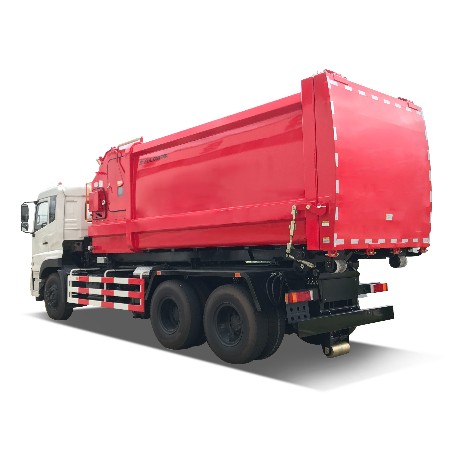Refuse compactors are essential tools in modern waste management. These machines are designed to compress large volumes of waste into smaller, more manageable sizes. By reducing the volume of waste, compactors help minimize the number of trips needed to transport waste to disposal sites, thereby cutting down on fuel usage and emissions. They also help in optimizing the space in landfills, extending their lifespan. Refuse compactors come in various shapes and sizes, tailored to different waste management needs, and among these, the movable refuse compactor stands out for its versatility and efficiency.
What is a Movable Refuse Compactor?
A movable refuse compactor is a type of waste compactor that is designed to be easily transported from one location to another. Unlike stationary compactors, which are fixed in place, movable compactors offer flexibility and convenience, making them ideal for dynamic waste management scenarios. These compactors typically feature wheels or are mounted on trailers, allowing them to be moved to different sites as needed. They are equipped with a powerful hydraulic system that compresses waste into dense, compact bales, significantly reducing its volume.

Types of Movable Refuse Compactors
Movable refuse compactors come in several types, each suited to specific applications:
Self-Contained Compactors
These units are designed with an integrated container and compactor system, making them ideal for wet waste applications. They are often used in locations where waste needs to be compacted and transported as a single unit, such as restaurants, supermarkets, and hospitals.
Stationary Compactors with Mobility Options
These compactors are typically fixed but can be mounted on wheels or trailers for easy relocation. They are commonly used in industrial and commercial settings where large volumes of dry waste need to be managed.
Portable Compactors
These are smaller, highly mobile units designed for temporary or short-term use. They are perfect for events, construction sites, and other situations where waste needs to be managed efficiently but not permanently.

How Does a Movable Refuse Compactor Work?
- Loading: Waste is loaded into the compactor’s hopper, either manually or via automated systems such as conveyor belts or lifting mechanisms.
- Compaction: Once the hopper is filled, the hydraulic system activates, driving a powerful ram or press to compress the waste. The force applied by the hydraulic system can vary, but it is generally enough to significantly reduce the volume of waste.
- Storage: The compacted waste is then moved into a storage container, where it is held until the container is full. The high compaction ratio means that more waste can be stored in a single container, reducing the frequency of waste collection.
- Transportation: When the container is full, the entire unit can be transported to a disposal site. For self-contained units, this means the whole compactor and container are moved together. For other types, the compacted waste container is detached and transported separately.
- Disposal: At the disposal site, the compacted waste is either recycled, processed, or sent to a landfill. The compact nature of the waste makes handling and processing more efficient.
Uses and Applications
Movable refuse compactors are used in a variety of settings, each benefiting from their unique advantages:
Commercial Settings
In commercial environments like shopping malls, restaurants, and office buildings, movable refuse compactors help manage the constant flow of waste, ensuring clean and hygienic premises.
Industrial Sites
Factories and warehouses generate large amounts of waste that need efficient management. Movable compactors are ideal for handling bulky and high-volume industrial waste.
Construction Sites
Construction sites often produce significant waste in the form of debris, packaging, and unused materials. Movable compactors help keep these sites clean and safe by regularly compacting and removing waste.
Events and Festivals
Large gatherings such as concerts, fairs, and sports events generate substantial waste. Movable compactors provide a convenient solution for managing this waste on-site, reducing the burden on local waste management services.
Residential Complexes
In large residential areas, movable compactors can be used to manage household waste effectively, reducing the need for frequent waste collection services and keeping the environment clean.

Benefits of Using a Movable Refuse Compactor
1. Efficiency in Waste Management
Movable compactors significantly reduce the volume of waste, making collection and transportation more efficient. This efficiency translates to lower operational costs and less environmental impact.
2. Cost Savings
By reducing the frequency of waste collection trips and optimizing landfill space, movable compactors help save on fuel, labor, and disposal fees. This makes them a cost-effective solution for both small businesses and large industrial operations.
3. Environmental Impact
Reducing the volume of waste means fewer trips to landfills, leading to lower carbon emissions. Additionally, the compacted waste takes up less space in landfills, helping to extend their lifespan and reduce the environmental footprint.
4. Convenience and Flexibility
The mobility of these compactors allows them to be used in various locations as needed. This flexibility is particularly useful in dynamic environments like construction sites and large events, where waste management needs can change rapidly.
Conclusion
In the realm of waste management, movable refuse compactors offer a versatile and efficient solution to some of the most pressing challenges. Their ability to significantly reduce waste volume, coupled with their mobility and flexibility, makes them an invaluable asset in commercial, industrial, and residential settings.






